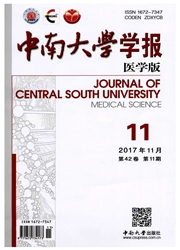

 中文摘要:
中文摘要:
目的:观察无创正压通气(nasal intermittent positive pressure ventilation,NIPPV)对慢性阻塞性肺疾病急性加重(acute exacerbations of chronic obstructive pulmonary disease,AECOPD)合并Ⅱ型呼吸衰竭患者血浆N端脑利钠肽(N-terminal pro-brain natriuretic peptide,NT-proBNP)水平的影响并探讨其意义。方法:随机选择AECOPD合并Ⅱ型呼吸衰竭患者及慢性阻塞性肺疾病稳定期患者各40例,检测血浆NT-proBNP水平并分析其与动脉血气、APACHEⅡ评分及肺动脉压力之间的相关性;比较两组血浆NT-proBNP水平;比较NIPPV治疗前后AECOPD合并Ⅱ型呼吸衰竭患者血浆NT-proBNP水平。结果:血浆NT-proBNP与pH值、PaO2呈负相关(分别为r=-0.691和r=-0.704,均P〈0.001),与PaCO2或APACHEⅡ评分呈正相关(分别为r=0.774和r=0.810,均P〈0.001),与肺动脉压力呈正相关(r=0.965,P〈0.001);AECOPD合并Ⅱ型呼吸衰竭患者血浆NT-proBNP与pH值、PaO2呈负相关(分别为r=-0.636和r=-0.616,均P〈0.001),与PaCO2,APACHEⅡ评分呈正相关(分别为r=0.545和r=0.475,P=0.001,P=0.002),与肺动脉压力呈正相关(r=0.833,P〈0.001);AECOPD合并Ⅱ型呼吸衰竭组血浆NT-proBNP明显高于慢性阻塞性肺疾病稳定期组[(939.60±250.00)pg/mL vs(151.55±111.20)pg/mL,P〈0.01];NIPPV治疗24 h后血气指标好转、APACHEⅡ评分下降,血浆NT-proBNP较治疗前下降[(229.15±98.26)pg/mL vs(939.60±250.00)pg/mL,P〈0.01];治疗后肺动脉压力较治疗前下降,但差异无统计学意义(P=0.056)。结论:血浆NT-proBNP浓度反映了AECOPD合并Ⅱ型呼吸衰竭患者病情的严重程度;NIPPV能降低该类患者的血浆NT-proBNP浓度,NT-proBNP浓度变化有助于评价NIPPV疗效。
 英文摘要:
英文摘要:
Objective:To investigate the effect of nasal intermittent positive pressure ventilation(NIPPV) on N-terminal pro-brain natriuretic peptide(NT-proBNP) in patients with acute exacerbations of chronic obstructive pulmonary disease(AECOPD) and typeⅡrespiratory failure.Methods:Forty patients with AECOPD and typeⅡ respiratory failure and 40 patients with stable phase chronic obstructive pulmonary disease were randomly assigned into study.Plasma levels of NT-proBNP,arterial blood gas,APACHEⅡ scores,and pulmonary artery pressures were measured.The plasma level of NT-proBNP was compared between the two groups.Effect of NIPPV on NT-proBNP was studied in patients with AECOPD and typeⅡrespiratory failure. Results:There were negative correlations between NT-proBNP and pH,and between NT-proBNP and PaO2(r=–0.691,r=–0.704,respectively;P0.001),positive correlations between NT-proBNP and PaCO2,and between NT-proBNP and APACHEⅡ scores(r=0.774,r=0.810,respectively,P 0.001),and positive correlation between NT-proBNP and PAP(r=0.965,P0.001) in all patients.In patients with AECOPD and typeⅡrespiratory failure,there were negative correlations between NT-proBNP and pH,and between NT-proBNP and PaO2(r=–0.636,r=–0.616,respectively;P0.001);there were positive correlations between NT-proBNP and PaCO2,and between NT-proBNP and APACHEⅡ scores(r=0.545,r=0.475,respectively;P=0.001,P=0.002);and there were positive correlation between NT-proBNP and pulmonary artery pressure(r=0.833,P0.001).The plasma levels of NT-proBNP were significantly higher in patients with AECOPD and type Ⅱrespiratory failure than in control subjects [(939.60 ± 250.00) pg/mL vs(151.55 ± 111.20) pg/mL;P0.01].NIPPV decreased plasma levels of NT-proBNP [(229.15 ± 98.26) pg/mL vs(939.60 ± 250.00) pg/mL;P0.01] in patients with AECOPD and typeⅡrespiratory failure,as well as improved arterial blood gas and APACHEⅡscores.Although NIPPV appeared to decrease pulmonary artery pressure somewhat bet
 同期刊论文项目
同期刊论文项目
 同项目期刊论文
同项目期刊论文
 期刊信息
期刊信息
